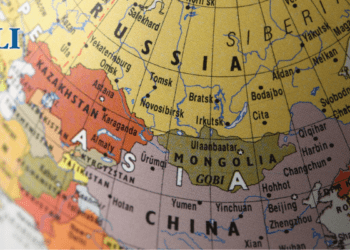 China’s newest indigenously built aircraft carrier is smaller and less capable than US supercarriers, writes David McDonough. But it is indicative of China’s growing naval ambitions that need to be taken very seriously.
China’s newest indigenously built aircraft carrier is smaller and less capable than US supercarriers, writes David McDonough. But it is indicative of China’s growing naval ambitions that need to be taken very seriously.
By David McDonough, May 4, 2017
The world’s attention has been rightly focused on North Korea. Yet, even as the USS Carl Vinson carrier strike group makes its way across the western Pacific, China has made additional waves by launching its first indigenously built aircraft carrier at a shipyard in Dalian – the second to join its fleet.
With this carrier, Beijing joins a small, very select group of countries, including the US, UK, and France, that have the means to construct aircraft carriers domestically.
It’s important not to overstate the significance of this development. The nuclear-powered USS Carl Vinson has a fully loaded displacement of 100,000 tonnes – compared to the 70,000 tonnes for China’s new Type 001A carrier. The Nimitz-class ship is armed with an array of anti-air and anti-ship weapons and countermeasures, to say nothing of a carrier air wing of fighters and support aircraft (normally 60-70) that can be launched using its catapult launch and arrested recovery system.
Both of China’s carriers do have some important features, however. The Liaoning may be a refurbished Soviet Kuznetsov-class ship purchased from Ukraine, but it has been extensively outfitted with electronics, radar, and weapons systems. The Type 001A carrier, while based on this old Soviet design, also boasts some important design improvements, including more advanced radar, more space for its crew, and the capacity for a slightly larger air wing (32 versus 24 aircraft).
China is still limited by its reliance on the old Soviet Kuznetsov-class design. For instance, its carriers lack a steam-powered catapult to launch aircraft; instead using an older, inefficient ski-jump configuration.
Still, even the larger Type 001A carrier can, at best, only carry roughly half the aircraft of a Nimitz-class supercarrier. China is still limited by its reliance on the old Soviet Kuznetsov-class design. For instance, its carriers lack a steam-powered catapult to launch aircraft; instead using an older, inefficient ski-jump configuration, in which aircraft expend their own fuel for take-off. This reduces the operational range of its naval aviation and limits the size and weight (including payload) of the carrier-based aircraft.
The USS Carl Vinson is only one supercarrier of a US fleet of 10. Two new ships, of the more advanced Gerald R. Ford-class, are on their way. Importantly, these ships have an electrical generation capacity that dwarfs their predecessor – a feature helping to power its electro-magnetic catapult-launch system and which opens the way for direct energy weapons and electro-magnetic railguns.
It’s also easy to forget that some US amphibious assault ships, while geared towards amphibious warfare, can also be used for more traditional naval power projection. For example, the US Marine Corps has eight Wasp-class assault vessels that displace 40,000 tonnes (comparable in tonnage to India’s new Vikrant-class carriers) and can be deployed with a complement of vertical take-off and landing aircraft and anti-submarine warfare (ASW) helicopters for sea control missions.
All this is to say the US capability for blue-water power projection remains exceedingly strong. Indeed, supercarriers operate in formidable carrier strike groups involving guided-missile destroyers, cruisers, nuclear attack submarines (SSN), and other support vessels. The US military has decades of experience operating the complex system of systems required for carrier aviation.
In contrast, China has been using its first aircraft carrier, the Liaoning, largely to train its sailors and air crews to operate on a flat top. It will likely take many years to master the skills required for such operations, even if there is the possibility of leveraging US lessons here.
They are “starter carriers,” to use scholar Andrew Erickson’s term, rather than training vessels per se. But that is still a far cry from the fully operational and battle-tested supercarriers the US operates.
Therefore, the Liaoning should not be seen as an immediate game changer – and neither should its slightly larger sibling, the unnamed Type 001A. Both have the capabilities to undertake important missions, from providing air cover to other naval forces to a possible anti-submarine warfare role. They are “starter carriers,” to use scholar Andrew Erickson’s term, rather than training vessels per se. But that is still a far cry from the fully operational and battle-tested supercarriers the US operates.
However, while not an immediate game changer vis-à-vis the US, these carriers do point to a worrisome trend – the accelerating growth in Chinese naval capabilities.
A good case in point is the number of ships being commissioned by the People’s Liberation Army’s Navy (PLAN). In 2016 alone, it commissioned 18 ships of various types, which in total tonnage displaced at 150,000 tonnes – or what the China Daily noted was half the entire British naval fleet. From 2000-2016, the PLAN commissioned 19 destroyers, 29 frigates, 45 submarines and, since 2013, 30 corvettes, most of which are modern in their design and capabilities.
This does not mean the PLAN has grown in absolute terms, as older ships are being retired. But it does mean the PLAN’s naval force is becoming increasingly modern. A good example is how its Luyang-III destroyer and Jiankei-II frigates are armed with vertical launch systems and phased-array radars that look remarkably like US Aegis systems – and which will provide an important area air defence (AAD) capability. Or the fact that the much smaller corvettes are geared towards anti-submarine warfare (ASW) – a traditional weakness of the PLAN.
Within this chain, China would benefit from a number of shore-based assets that would make unfettered access to this environment difficult, even for the US Navy (USN).
China’s naval forces would pose a particularly formidable challenge within the first island chain, connecting the islands of Japan, the Philippines, and Indonesia. Within this chain, China would benefit from a number of shore-based assets that would make unfettered access to this environment difficult, even for the US Navy (USN) – including advanced surface-to-air missile (SAM) systems, a growing fleet of fourth-generation aircraft (the largest after the US and Russia), land-attack cruise missiles and ballistic missiles, and a mobile anti-ship ballistic missile that could potentially hold at-risk targets even beyond the first island chain.
China’s naval force is arguably one of the more potent examples of what Alfred Thayer Mahan called a fortress fleet – a force that uses shore-based assets as a protective cover. Of course, Mahan never envisioned that the reach of these shore-based assets would go so far beyond the immediate coastal littoral.
Yet, China’s two aircraft carriers indicate even more ambitious plans for a blue-water naval force – one that isn’t so reliant on coastal, shore-based systems for protection. That puts into perspective the PLAN’s focus on AAD and potentially ASW. PLAN ships are already extensively armed with anti-ship missiles, giving them an important offensive means to deny the maritime domain from potential adversaries – or sea denial. But AAD and ASW are widely considered critical defensive capabilities necessary for the PLAN to protect its forward deployed naval forces, such as carrier strike groups, operating away from shore-based assets – helping to ensure that the more challenging goal of sea control is achieved.
A possible indicator on the extent of China’s ambitions can be found in the words of an unnamed Chinese defence analyst, who told the People’s Daily that China requires five to six aircraft carriers – for two carrier strike groups in the western Pacific and two for the Indian Ocean.
Irrespective of whether this is official government policy, China is moving to make this vision a reality. With the Luyang-III and Jiankei-II, China already has the initial elements of a surface escort for its carriers. Importantly, it is reportedly working on a guided-missile cruiser (Type 055) with a displacement of 10,000-12,000 tonnes. Larger than the USN’s Arleigh Burke-class destroyer, the Type 055 is expected to have a long range and be multi-mission capable with anti-air, anti-surface, and anti-submarine capabilities – and likely to serve as the core of any PLAN carrier strike group.
China also appears to have plans for an expanded fleet of nuclear attack submarines, with the much quieter Type 095 expected to be constructed at its new advanced facility at Huludao, Liaoning Province.
Last, even as it launches its Type 001A, China is also currently constructing its third aircraft carrier at a shipyard in Shanghai. Notably, this is expected to be a much larger, possibly nuclear-powered vessel – with more room for aircraft than its predecessors. The Type 002 will actually use a catapult-launched and arrested recovery system, making it both a fundamental departure from China’s reliance on old Soviet designs and much closer in appearance and function to US aircraft carriers.
US defence planners should be concerned by China’s naval ambitions. The USN may enjoy a strong quantitative (in terms of modern ships) and qualitative advantage today. But the former is mitigated by the extent to which the USN is a globally deployed force compared to the regionally focused PLAN. The latter is being degraded by both asymmetrical measures geared to deny US access to the near seas, as well as more symmetrical efforts to turn the PLAN into a truly blue-water fleet.
If it continues, China will have the second largest navy in the world by 2020 and a combat fleet that, in terms of hardware, “is quantitatively and even perhaps qualitatively on a par with that of the USN by 2030.”
China does have some important hurdles still to overcome, not least in its naval propulsion systems. Still, the trend lines here are especially worrisome – and not just to the USN, given the limits of Japan’s power projection capabilities and structural weaknesses curtailing India’s own naval ambitions. As Erickson notes, if it continues, China will have the second largest navy in the world by 2020 and a combat fleet that, in terms of hardware, “is quantitatively and even perhaps qualitatively on a par with that of the USN by 2030.”
If that comes to pass, then the arrival of the Liaoning and the Type 001A carriers would indeed be remembered as an inflection point – when US strategic predominance in the western Pacific began to give way to Chinese predominance.
David McDonough is Deputy Editor at the Macdonald-Laurier Institute and a Research Fellow at Dalhousie University’s Centre for the Study of Security and Development.




